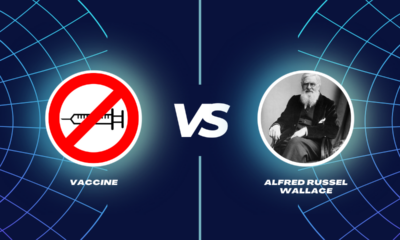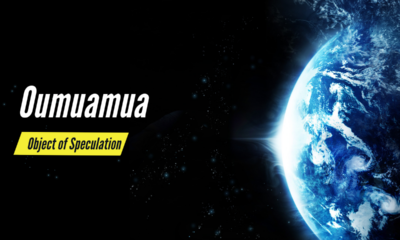Creation Corner
Brown’s Razor and economy of miracles
Brown’s Razor, or the Law of Economy of Miracles, tells us not to invoke miracles unless the Bible says so. That can keep us honest.

Recently a creation advocate, whom I will not name, refused “honorable mention” at the Creation Science Hall of Fame. He gave this reason for so acting: God, he says, never uses “natural processes” to do the great things He does. This applies as much to the Global Flood (Genesis chh. 6-8) as to Creation itself (Genesis 1:1-2:4a). Everything in either event, must be a miracle. This makes it as good a time as any to discuss, and propose, a statement on economy of miracles. I call it Brown’s Razor, after Walter T. Brown, originator of the Hydroplate Theory of the Global Flood. In fact, Brown and I have discussed economy of miracles often, in conversation and correspondence.
Why Brown’s Razor?
Brown’s Razor takes its name from two persons:
- Walter T. Brown, as I have noted above, and
- William of Occam, who propounded the first Razor.
Occam’s Razor states: “one does not multiply guesses without sufficient reason.” In paraphrase: the simplest explanation that fits all observations is the preferable one.
Likewise, Brown’s Razor states: one does not invoke miracles without sufficient and highly specific chapter-and-verse attestation in Scripture. Again, in paraphrase: the simplest explanation that fits Scriptural testimony is the preferable one.
What does Brown’s Razor imply? For one thing, the Global Flood does not have to be a miracle. Indeed I propose that the real miracle in the Flood story was Noah receiving, 120 years in advance:
- Warning of the event, and
- The design for a ship that would protect him, his family, and a critical set of breathing, land-walking specimens from the roughest seas the Flood would throw at it.
In addition, Scripture attests that God sent a favorable wind at a critical moment to protect that ship—Noah’s Ark—from swamping.
But Scripture does not attest that the Flood and everything we associate with it were miracles.
Why does Brown’s Razor matter?
To apply miracles to everything is to risk putting God to the test. And we know that God frowns on such behavior? How? Read the story of the Devil tempting Jesus to jump from the pinnacle of the Temple.
Let us apply Brown’s Razor together with another principle: the Method of Exclusion. To do this, let us assume that:
- The Flood was one great miracle, and
- The mountains of today were just as tall before the Flood as after.
Then how could Noah and his family and their living land-animal specimens have breathed?!? That would require another miracle, becausethe Flood would have had to rise to cover Mount Everest! Which, as everyone knows, rises as high as an airliner flies. You need self-contained high-altitude breathing apparatus, in the form of tanked oxygen, before you dare climb that mountain!
Yet Scripture says the Flood waters covered the highest land at the time to a depth of “fifteen cubits,” or about twenty-two-and-a-half feet. Or deeper, because we do not know how long an antediluvian cubit was. (The depth that Scripture quotes, is probably the draft of the Ark. That’s how deep below the water the lowest part of a ship reaches.)
Adding miracle to miracle?
One could add miracle to miracle—and make people wonder why God does not work such plethoras of miracles today. Or one could apply Brown’s Razor, and the physical evidence. Both of which suggest that the mountain chains we know today, reared up when the continental plates:
- Rammed one another (to form the Himalayas), or else
- Fell as wrinkled sheets (to form the Rocky, Andean, Pyrenees, Appenine, Alpine, Ural, and similar chains and massifs).
Riddles of astronomy…
Astronomy and mineralogy present worse problems for the assumption of miracles. If we maintain that everything in the Flood was a miracle, then we must explain certain features of our modern world that do not conform, by any reasonable standard whatsoever, to the evaluation of the world of Genesis chapter 1 as “very good.” (Hebrew mo’ed tov, which, when translated justly, means absolutely excellent.) Who can genuinely consider any of the following to be part of a “very good” creation?
- Comets, asteroids, and meteoroids–the Mavericks of the Solar System
- Radioisotopes
- “Heavy” isotopes
- Any of the small and often mis-shapen moons of Mars and the gas giants
Comets, in particular, have a dire reputation. “Evil stars!” the ancients called them, or to use the literal Greek name, disastroi—disasters. In the centuries following the Flood, comets fell back to Earth often. They didn’t necessarily create catastrophic impacts, but they did create frightening celestial displays. As late as 1066, comets retained their reputation as portents of doom. Anglo-Saxon nobles noted the passage of Comet 1P/Halley, one day before the Battle of Hastings. As Matilda, queen consort to William the Conqueror, embroidered in her famous Tapestry.
Beyond a frightening display is a more frightening prospect of impact. Great craters persist today, including the great meteor crater of Arizona and (some say) the Gulf of Mexico. Earth’s Moon, for its part, suffered a tremendous bombardment that put the Moon into tidal lock with Earth.
…and mineralogy
Radioactivity obviously makes people and living things sick! Nor are the heavy isotopes totally without harm. Proteins that incorporate heavy atoms of certain elements cannot fold or “conform” properly. This fact, at least as much as radiocarbon and that background radiation that was unknown before the Flood, explains why the lifespan of mankind declined ninety percent in eleven generations after the Flood. And continued to decline during the Age of the Patriarchs.
Did any miracles occur?
Yes. Miracles come in two varieties. When something happens against very long odds, that is a miracle. And when something happens in violation of the physical laws of the universe, that certainly is a miracle. King Hezekiah of Judah knew this, when he asked that God roll back the shadow on a sundial by ten steps. So did Judge Gideon when he asked that God present him a dry fleece with surrounding ground wet with dew.
We can comfortably consider the creation of the Earth, the Moon, the Sun, and life itself a set of miracles. In fact, in addition to the three bodies named above, the following bodies are likely to be part of the original miraculous Creation:
- All the planets we observe, from Mercury to Neptune. (Except for Uranus and Neptune, the ancients knew of these objects.)
- The four largest moons of Jupiter, that we call the Galileans after Galileo Galilei, who discovered them.
- Titan, the largest moon of Saturn.
Everything else in the Solar system, added together, would weigh about four percent as much as Earth. Not too difficult, then, to assume that these other objects form when Earth shed four percent of its mass in the most violent event it has known since its birth, i.e., the Flood.
So Brown’s Razor does not preclude miracles entirely. It merely asserts that one should reserve miracles for things one cannot explain without them. Not, that is, without violating the original Occam’s Razor.
When secular explanations fail
Those who object most strenuously to Brown’s Razor or anything like it, express the fear that it makes God Unnecessary. This cannot be true. To “make God Unnecessary” requires a very long time span—four point six billion years for the Solar system as a whole.
If the Solar system were that old, the Mavericks of the Solar System would mostly have cleaned themselves out. This applies to the comets. Of course, Jan Oort tried to explain why the comets didn’t dim to invisibility long ago. He proposed a “cloud” of comets surrounding the Sun at an incredible distance. This “Oort cloud” fails for an obvious reason: we’ve never seen it. Indeed, neither Voyager 1 nor 2 ran into it, as they surely would have by now.
Life on Earth presents two problems: origin and a limit on the life span of species. Individual life spans aren’t the problem. Geneticists today speak of genetic entropy, a concept they borrow from thermodynamics. Simply put, after enough generations, offspring have so many genetic diseases that they cannot survive even to make another generation. Humankind should have gone extinct long ago.
They can’t explain it
These and other observations argue for a young Earth and a young Solar system. Which is why secular scientists deny them or try ever more complex ways to explain them apart from miracles. Ironically, they propose a series of miracles of the game-winning kind to explain the beginning of life. They then propose that life will go on with only the stars to limit it.
But the inability of secular observers to explain what they observe, doesn’t excuse us to decline to explain these things properly. And it certainly does not require that we abandon the attempt! Brown’s Razor, or an economy of miracles, can keep creation apologists honest.
About the image
“William of Occam, Ockham” by sludgegulper is licensed under CC BY-SA 2.0
-

 Executive4 days ago
Executive4 days agoSecret Service chief gets no solace
-

 Civilization5 days ago
Civilization5 days agoBiden drops out of race
-

 Executive2 days ago
Executive2 days agoWaste of the Day: Louisville Taxpayers Pay Nearly $600,000 For Empty Building’s Maintenance, Security
-

 Guest Columns4 days ago
Guest Columns4 days agoFear Itself: Democrats’ Favorite Strategy Caused Their Current Chaos
-

 Executive3 days ago
Executive3 days agoWhere is Joe Biden – or Jill?
-

 Executive1 day ago
Executive1 day agoWaste of the Day: Throwback Thursday: Cities Used Crime Prevention Funds on Soccer Games, Paper Shredding
-

 Civilization4 days ago
Civilization4 days agoBuild Iron Dome in the United States To Prepare for Israel’s Worst Day
-

 Executive2 days ago
Executive2 days agoFacile and politically motivated suggestions















Please explain why, if the world was completely covered by water such that Everest was submerged, the air pressure at this new raised sea level would be significantly different than sea level air pressure today?
What happened to the ~29,000-foot-thick shell of air between sea level and the top of Everest?
You do realize that, in making that claim, you destroy the usual objection people make to the Global Flood: namely that if the Flood waters covered Mount Everest, the air up there would be unbreathable.
You atheists need to get your stories straight and keep them straight.
You are the only person that I have seen make that claim, and you seem to believe it, which is why I’m asking you to support it. Your response was not that the pressure problem was based on a flawed premise, but instead that Everest wasn’t so high at the time of the Flood. The pressure problem can’t be evidence that Everest was a low hill at the time if there is no pressure problem.
There are two options here:
1) You believe that the air over a flooded 29000′ Everest would have been too thin to breathe.
OR
2) You don’t think the air over a flooded 29000′ Everest would have been too thin to breathe.
Your arguments all reflect a belief in case 1, which you say would require a second miracle. To avoid invoking a second miracle, you propose, not a normal pressure in that situation, but rather _a lower mountain_.
So again, why would the air over a flooded 29000′ Everest have been too thin to breathe?
No explanation, I guess.
Well, we can try something else: why would Voyager 1 (currently 151 AU from the Sun) or Voyager 2 (currently 125 AU from the Sun) have been expected to have run into the Oort cloud by now, when the inner edge of the Oort cloud is proposed to be at >2000 AU?
Does it have anything to do with Dr. Brown’s once-proposed Jupiter’s-worth of mass out beyond Neptune? The one that the Voyagers should have run into by now?
link to cnav.news
link to cnav.news
A Jupiter’s worth mass beyond Neptune? I never read anything like that, or heard that from him. We’re talking about four percent of the original mass of the Earth, total, for asteroids, Kuiper belt and Scattered Disk objects, meteoroids, comets, and the small, irregularly shaped moons of Mars and the gas giants. That, now that I read the reference you provided, was your idea, not his.
And why didn’t the Voyagers run into the nursery for the short-period comets?
No, a Jupiter-mass beyond Neptune is purely you and Brown:
link to cnav.news
“If the solar system is less than one percent heavier than people think, a comet like ISON does not even feel the full effect of its gravity until it is much further away.”
“Brown has always suspected the Solar System has more mass than the total catalogued amount. He also suspected astronomers would find this extra mass beyond the Kuiper Belt. Here’s why: orbiting mass beyond any one object exerts no pull on that object. But once the object moves beyond that mass, it is now subject to the cumulative pull of that extra mass and everything else inside it. So an object could achieve an aphelion of 50,000 AU, yet have a resultant period far shorter than 4 million years. With enough mass, such a comet could have a resultant period well shorter than the 5300 years that elapsed since the Global Flood.”
“They’re discovering new Trans-Neptunian Objects every week, it seems. [And] the distribution of the mass matters. If it’s a shell, you need more mass to pull the comet back in. If it’s a disk, you need less, because more of that mass will pull it in as it passes it.”
link to cnav.news
“Both calculations are extremely sensitive to the mass of the solar system. If this mass has been underestimated by as little as about 17 parts in 10,000 (about the mass of two Jupiters), the true distance would be 585 AU and the period only 5,000 years.”
link to creationscience.com
“What if two comet sightings, a century or more apart, were of comets which we assumed had such long periods that they should not be the same comet, but whose orbits were so similar they probably were the same comet? We might suspect that both sightings were of the same comet, and it encountered some extra mass beyond 30 AU (in the Kuiper Belt) that pulled it back much sooner than expected. twelve “strange pairs” are known, suggesting that extra, unseen mass beyond Neptune’s orbit affects long-period comets but is not felt within the planetary region.”
link to creationscience.com
“28. This can be seen by recalling the “Hollow Shell” example on page 314. The Kuiper Belt (and to a lesser extent, the asteroid belt) can be thought of as approximately consisting of thousands of thin, concentric, spherical shells—like rings in an onion. A comet inside any shell would not feel its gravitational pull. However, comets outside a shell would feel, for up to thousands of years, a gravitational pull equal to that of the shell’s entire mass concentrated at the center of that shell.”
“111. My computer simulations of the solar system during its last 350 years have shown that Herschel-Rigollet did not come near enough to any planet for that gravity boost. Therefore, its gravity boost probably came from mass beyond 30 AU.”
link to creationscience.com
“The Kuiper Belt—a doughnut-shaped region 30–50 AU from the Sun—contains about 70% of all TNOs—those with nearly circular orbits near the plane of the ecliptic. According to the hydroplate theory (as will be explained), radial forces and the Sun’s energy acted on the larger asteroids and spiraled them out beyond Neptune where they are now called TNOs, not asteroids. TNOs are larger than asteroids in the inner solar system—except for a few asteroids that may have merged after the flood. TNOs have a total weight of 3% of Earth’s mass, give or take 1%.149”
Brown’s assertion that the asteroid belt or Kuiper belt act, gravitationally, like hollow spherical shells of material is wrong on its face. So is his (or your) assertion that “orbiting mass beyond any one object exerts no pull on that object” – you already know that, because the Moon doesn’t fly out of Earth orbit at every solar eclipse. But let’s ignore those fallacies. What we see above are claims that:
1) There is mass out “beyond the Kuiper Belt”/”beyond 30AU”/”Trans-Neptune” that bends cometary orbits such that they are not ellipses but some more complicated shape that merely resembles an ellipse on the observed, inner part of the orbit.
2) How much mass? Apparently about 1% of the total mass of the Solar System: “one percent heavier”; “(about the mass of two Jupiters)”
3) The TNOs, in Brown’s claim, are 2-4% of Earth’s mass. That’s nowhere near the “two Jupiters” mentioned elsewhere.
4) Ergo, per you and Brown, there remains an undetected Jupiter-mass in some unstated distribution somewhere out there, either in or beyond the Kuiper belt. If the mass of the TNOs is supposed to be all that’s out there, that doesn’t provide enough gravity to warp the comet orbits in the way that you want. Putting the mass in a disc or torus or shell doesn’t change the problem that 3% of Earth’s mass <<100 AU out of the plane of the ecliptic, in opposite directions (V1 North, V2 South). The Kuiper Belt is on the order of 10 AU thick. What interaction with the Kuiper Belt or Scattered Disc were you expecting?
Looks like a chunk got lost from that last paragraph:
…Putting the mass in a disc or torus doesn’t change the problem that 3% of Earth’s mass <<< "about the mass of two Jupiters".
The Voyagers are currently both more than 100 AU out of the plane of the ecliptic…
Anyway, you got me monologuing, you rascal! I still don't know why you believe that the air over a flooded 29000' Everest would be too thin to breathe. Or why the Voyagers should have run into the Oort cloud by now.